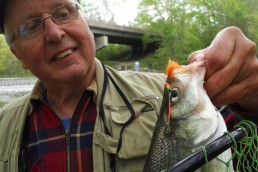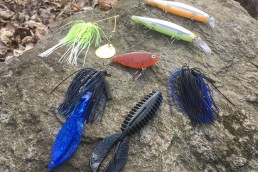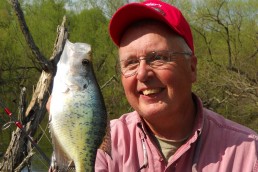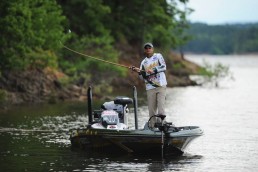‘White Lightning’ Strikes Ohio in the Springtime
SHARE THIS POST
This spring there will be “white lightning” in the hills and streams. Best of all, the taking of this white lightning is legal and can found all over the state. This is actually the super-charged white bass making their spring spawning run that they start in April and continue into May; in northern Ohio it may end in June. At times, the action can be so frenetic that it satiates the fish-catching hunger of most avid fisherpersons.
While some anglers may fish some waters from a boat, most either bank-fish or wade for them. When the run is timed correctly, these fish can be caught on almost every cast. Their savage strikes and hard fights are done with reckless abandon.
The number one spot for springtime white bass is the Maumee River, near Toledo.
“The white bass start showing up in numbers in the Maumee River about the third week of April,” says Gary Lowry, an avid Maumee River angler and owner of Maumee Tackle and Bait. “They are in the river until the first week of June. The peak period usually is the first or second week of May.”
He added that the average size for a white bass here is 12 to 14 inches, with some at 18 inches coming in, and in numbers.
“When the angler finds a good school of white bass, 50 or more are likely.”
A bonus in April and early May are the walleyes as they start spawning before the white bass appear in the Maumee. Some even some stick around during the first part of the white bass run.
On the Maumee, 1/16- and 1/8-ounce jigs work well. Tip these lead heads with 2- to 3-inch Twister Tail grubs in their Chartreuse or White. While some anglers only fish one jig, others like two. (Check the state regulations for special rules regarding the Maumee, Portage, Mahoning and Sandusky rivers.) Having two 14-inch white bass on the same fishing rod can quickly test the mettle of an angler.
Jigs take white bass, and small Mepps Aglia spinners, Little Cleo spoons and small crankbaits are also productive. For the live-bait purist, head-hook a minnow on the jig. Some bank anglers like to fish a live minnow beneath a bobber and let the current drift it downstream into a pool.
There’s nothing worse than driving a long distance only to find out that the run hasn’t started or the stream is at flood stage. Lowry has a website (maumeetackle.net) and he updates it at 6 a.m. every morning from March 1 through June. It contains fishing reports, river conditions and fishing tips.
Are you enjoying this post?
You can be among the first to get the latest info on where to go, what to use and how to use it!
Besides the Maumee River, the Sandusky and Portage rivers also experience white bass runs from Lake Erie. While not as well known, these tributaries can also produce numbers of big white bass.
The majority of anglers who fish Erie tributaries work the riffle areas where the white bass spawn. However, there are some savvy anglers who get an early jump on the white bass run. From small boats and off piers, they catch staging pre-spawn fish at the river mouths. They’ll also extend the season by catching them in June at these same spots, where these white bass return to Erie after their courtships. Again, when fishing Lake Erie tributaries, check for all regulations during spring.
Don’t neglect Lake Erie’s western basin islands. In May and June, numbers of big white bass are taken from the shorelines of the islands and the offshore reefs. Jigs and twister tails, spinners, spoons and crankbaits catch numbers, and some are huge.
Not all the spawning action is confined to the northern tier of Ohio. Tributaries that flow into the Ohio River can also offer white bass action. The southwestern part of the state has several streams that can provide good to excellent opportunities. However, some years are better than others. High and muddy waters make fishing tougher, even when there are lots of fish. The best locations on these streams depend on the size of the tributaries. The Great and Little Miami rivers are larger streams, and more fish spawn in them. These streams cover more area and fish can swim several miles upstream. The bigger rivers can make it harder for the first-time visitor to find numbers. When in these tributaries, look for the white bass to be spawning in the riffles. Often, the first riffle is the best, but again, bigger waters can have fish several miles from the mouth.
White Oak, Eagle and Ohio Brush creeks are smaller tributaries, but at times they have good white bass runs. The first riffles usually are best. If it looks like there are no fish in the riffles, don’t believe it. Try casting lures and jigs to the deeper pools, undercut banks or log jams, especially on clear days during high sun. If there are no fish after these attempts, go home and come back a few days later.
Timing is critical as well during the spawning runs. Usually, the southern part of the state has runs that start in early to mid-April and last two to four weeks. The Ohio River in the southeast part of the state experiences white bass runs. The Scioto and the Muskingum rivers at the Devola Lock and Dam are two good streams too. Also, the tailwaters below the locks and dams all along the Ohio River experience large numbers of courting white bass.
For the rest of the state, don’t despair. If a reservoir is near your home it may have a decent white bass population. Chances are very good that there will be a spring white bass run in its feeder streams. Start checking for them in April and May. On these smaller tributaries, cast lures where the stream’s mouth enters a reservoir. Slowly work your way upstream, fishing all riffles and deeper holes. Again, pay special attention to the first riffle.
For these spawning bass, moderately clear water is best, but some days the stream is muddy. While it’s harder to catch fish in turbid waters, using lead-head jigs with dark-colored twister tails like black, purple or a “motor oil” color, can help. When using brighter colors, try hot pink or a red-orange hue. Use spinners with these same colors. Inline spinners with Colorado and Indiana blades work best too because they create a thumping sound under the water. Then, retrieve the lures slower than usual. In the dingy waters, also try fishing deep pools by slowly retrieving a red-orange marabou jig with a live minnow. On a second rod, fish minnows on a crappie rig with a bell sinker. Pay special attention to the current’s seam and search the slack-water side of the current break. In clear water, watch out for skittish fish in the riffles. Sometimes the spawning white bass are only in 1 and 2 feet. In this situation, use lighter lines, smaller jigs and twister tails. Make longer casts to these skittish fish, but if the bass aren’t in the riffles, just fish the deeper holes, especially if there’s cover.
This spring, if you’d like a good jolt of white lightning, why not enjoy Ohio’s spring white bass runs?
MWO
SHARE THIS POST
Did you enjoy this post?
You can be among the first to get the latest info on where to go, what to use and how to use it!
Paul Liikala
Paul Liikala was raised on a farm which was close to Lake Erie and the Grand River. He was fortunate to have parents who nurtured his love for the outdoors. His only hope is that his writings show the love and admiration that he has for the Great Outdoors and its participants.




